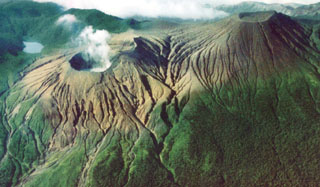Report on Rincon de la Vieja (Costa Rica) — 17 September-23 September 2014
Smithsonian Institution / US Geological Survey
Weekly Volcanic Activity Report, 17 September-23 September 2014
Managing Editor: Sally Sennert.
Please cite this report as:
Global Volcanism Program, 2014. Report on Rincon de la Vieja (Costa Rica) (Sennert, S, ed.). Weekly Volcanic Activity Report, 17 September-23 September 2014. Smithsonian Institution and US Geological Survey.
Rincon de la Vieja
Costa Rica
10.83°N, 85.324°W; summit elev. 1916 m
All times are local (unless otherwise noted)
OVSICORI-UNA reported that at 1237 on 17 September a seismic signal indicating a phreatic explosion at Rincón de la Vieja was detected by a station about 5 km S of the volcano. A second phreatic explosion, detected at 2048 and lasting three minutes, was of a larger magnitude and a longer duration that the first explosion. Phreatic explosions were also detected at 1825 on 19 September and at 0304, 0439, and 0634 on 20 September. Residents on the N flank heard the event on 19 September and saw the explosion at 0634 on 20 September. An overflight of the crater lake on 20 September revealed that the temperature of the lake water was about 45 degrees Celsius, an increase from about 30 degrees measured in April.
Geological Summary. Rincón de la Vieja, the largest volcano in NW Costa Rica, is a remote volcanic complex in the Guanacaste Range. The volcano consists of an elongated, arcuate NW-SE-trending ridge constructed within the 15-km-wide early Pleistocene Guachipelín caldera, whose rim is exposed on the south side. Sometimes known as the "Colossus of Guanacaste," it has an estimated volume of 130 km3 and contains at least nine major eruptive centers. Activity has migrated to the SE, where the youngest-looking craters are located. The twin cone of Santa María volcano, the highest peak of the complex, is located at the eastern end of a smaller, 5-km-wide caldera and has a 500-m-wide crater. A Plinian eruption producing the 0.25 km3 Río Blanca tephra about 3,500 years ago was the last major magmatic eruption. All subsequent eruptions, including numerous historical eruptions possibly dating back to the 16th century, have been from the prominent active crater containing a 500-m-wide acid lake located ENE of Von Seebach crater.
Source: Observatorio Vulcanologico y Sismologico de Costa Rica-Universidad Nacional (OVSICORI-UNA)

